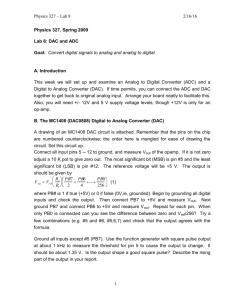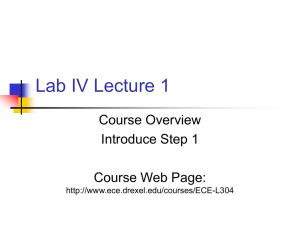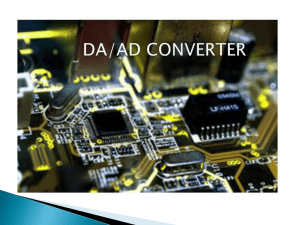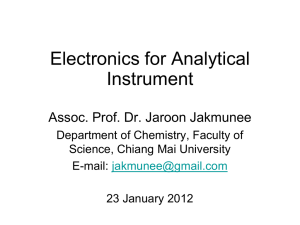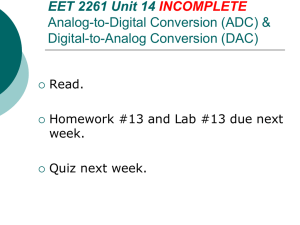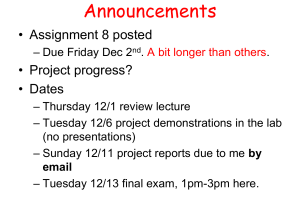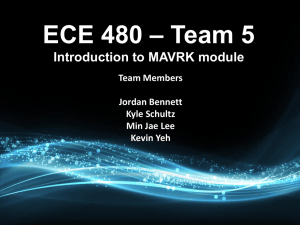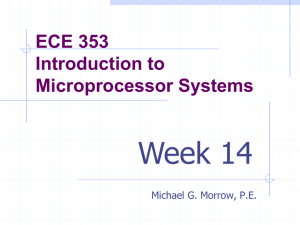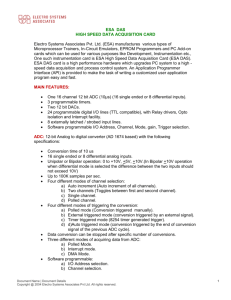PPTX Slides
advertisement
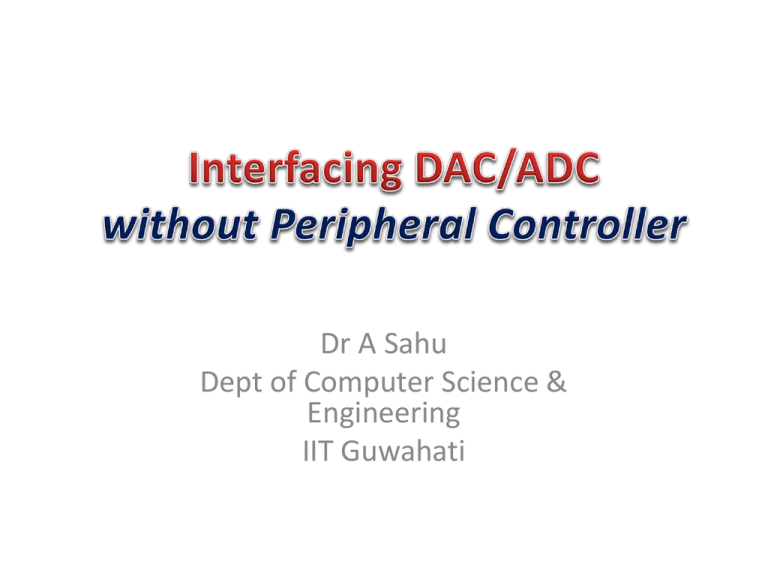
Dr A Sahu Dept of Computer Science & Engineering IIT Guwahati • Peripheral communications • DAC – Properties – Generic Model – Interfacing • ADC – Properties – Generic Model – Interfacing • Display Processor R A M • Peripherals : HD monitor, 5.1 speaker • Interfaces : Intermediate Hardware – Nvidia GPU card, Creative Sound Blaster card • Interfaces : Intermediate Software/Program – Nvidia GPU driver , Sound Blaster Driver software • • • • Read Instruction from memory Execute instruction Read/Write data to memory Some time send result to output device – LEDs, Monitor, Printer • Interfacing a peripheral – Why: To enable MPU to communicate with I/O – Designing logic circuit H/W for a I/O – Writing instruction (S/W) • Transmission Controller: – MPU control, Device Control (DMA) • Type of IO mapping – Peripheral (IN/Out), Memory mapped IO (LD/ST,MV) • Format of communication – Synchronous (T & R sync with clock), Asynchronous • Mode of Data Transfer – Parallel, Serial (UART) • Condition for data transfer – Uncond., Polling, Interrupt, Ready signal, Handshake • • • • • Used for play sound in speaker Used by AC97 (Audio codec) MP3 Sound store digital format in HDD Slow as compared to processor/MPU Parameters • Resolution (8 bit/16 bit) • Settling time (1micro sec) D2 D1 D0 Digital to Analog Converter Vo Analog Output Analog output FS 7 6 5 4 3 2 1 0 LSB 000 001 010 011 100 101 110 111 Digital Inputs • FullScaleOutput=(FullScaleValue – 1LSBValue) • 1MSB Value=1/2 * FSV D3=8 D2=4 2.5K 4K 5K Vout 10K D1=2 20K D0=1 • Vo= Vref/R * ( A1/2+ A2/4+…An/2n) • Vo is proportional to values of Data Bits Value • Resistive Ladder Network • Require two type Resistor • But small value R 2R R E G I S T E R – 5K and 10K R + Vout 2R Resistor R 2R 2R R R+R=2R 2R||2R=R • Cause: Signal and clock skew in circuits • Especially severe at MSB transition where all bits are switching – Vo 0111…111 → Time 1000…000 • Glitches cause waveform distortion, spurs and elevated noise floors • High-speed DAC output is often followed by a de-glitching SHA (Hold Buffer) • • • • • • Resolution Reference Voltages Settling Time Linearity Speed Errors • Amount of variance in output voltage for every change of the LSB in the digital input. • How closely can we approximate the desired output signal(Higher Res. = finer detail=smaller Voltage divisions) • A common DAC has a 8 - 12 bit Resolution Resolution VLSB VRef N 2 N = Number of bits Better Resolution(3 bit) Poor Resolution(1 bit) Vout Vout Desired Analog signal Desired Analog signal 110 8 Volt. Levels 2 Volt. Levels 111 1 110 101 100 011 010 001 0 Approximate output 0 Digital Input 101 100 011 010 001 000 000 Approximate output Digital Input • A specified voltage used to determine how each digital input will be assigned to each voltage division. • Types: – Non-multiplier: internal, fixed, and defined by manufacturer – Multiplier: external, variable, user specified • Settling Time: The time required for the input signal voltage to settle to the expected output voltage(within +/- VLSB). • Any change in the input state will not be reflected in the output state immediately. There is a time lag, between the two events. Analog Output Voltage Expected Voltage +VLSB -VLSB Settling time Time NON-Linearity(Real World) Desired/Approximate Output Analog Output Voltage Analog Output Voltage Linearity(Ideal Case) Desired Output Approximate output Digital Input Digital Input Miss-alignment Perfect Agreement 17 • Gain Error: Difference in slope of the ideal curve and the actual DAC output High Gain Error: Actual slope greater than ideal Low Gain Error: Actual slope less than ideal Analog Output Voltage High Gain Desired/Ideal Output Low Gain Digital Input • Rate of conversion of a single digital input to its analog equivalent • Conversion Rate – Depends on clock speed of input signal – Depends on settling time of converter • Used when a continuous analog signal is required. • Signal from DAC can be smoothed by a Low pass filter Digital Input Piece-wise Continuous Output 0 bit 011010010101010100101 101010101011111100101 000010101010111110011 010101010101010101010 111010101011110011000 100101010101010001111 n bit DAC nth bit Analog Continuous Output Filter • Design an output port with Address FFH to interface 1408 DAC • Write a program to generate a continuous RAMP waveform Output Time A15 A0 Address Bus (16bit) A7 A6 A5 A4 A3 A2 A1 A0 8085 MPU D7 D0 Data Bus (8bit) D7 D6 D5 D4 D3 D2 D1 D0 LE 74LS373 Latches 1408 DTOA: MVI OUT MVI DCR JNZ INR JMP A, 00H FFH B, COUNT B DELAY A DTOA ; Load Acc with first I/P ; Output to DAC ; Setup Reg. for Delay ; Next Input ; Go back to Output Slope of RAMP can be varied by changing Delay Analog Input Analog to Analog Converter D2 D1 D0 Digital output Vi 111 110 101 100 011 010 001 000 LSB 0 1 2 • ADC are slower then DAC • Interfaced using Status Check 3 4 5 6 7 Analog Input • Sampling • Fourier Transform • The process of reconstructing a signal from its values at discrete instants of time – Zero order hold or One Point – Linear or Two Point – Band limited or Low pass Filtering • Suppose my range is 0-1024 and assume some value of N between 0-1024 • You have to find the value of N – You can ask me (what about value X) – Answer ( N>X, N<X, N==X) – Operation with X (X++; X*2, X^2, X/2, X--) • What is the best Algorithm to find – Sequential ( increase X till X==N) O(N) algorithm – Successive approximation: (Binary Search) • Say R/2 as CMP( R/2, N) === if equal stop IF (R/2 < N) CMP (R/2+R/4,N) ELSE CMP (R/2-R/4, N) • If you have N persons to do the comparisons – Ask to all people and Gather the information • Mix of Both approach – If you have M comparator • Counter or Tracking ADC • Successive Approximation ADC – Most Commonly Used • Parallel or Flash ADC – Fast Conversion • Block diagram Clock Control Logic Counter DAC Vi • Operation – Reset and Start Counter – DAC convert Digital output of Counter to Analog signal – Compare Analog input and Output of DAC • Vi < VDAC – Continue counting • Vi = VDAC • Waveform – Stop counting – Digital Output = Output of Counter • Disadvantage – Conversion time is varied • 2n Clock Period for Full Scale input • Most Commonly used in medium to high speed Converters • Based on approximating the input signal with binary code and then successively revising this approximation until best approximation is achieved • SAR(Successive Approximation Register) holds the current binary value • Block Diagram • Circuit waveform • Conversion Time – n clock for n-bit ADC – Fixed conversion time • Serial Output is easily generated • Logic Flow – Bit decision are made in serial order • Very High speed conversion – Up to 100MHz for 8 bit resolution – Video, Radar, Digital Oscilloscope • Single Step Conversion – 2n –1 comparator – Precision Resistive Network – Encoder • Resolution is limited – Large number of comparator in IC Vinput A/D Converter START Digital O/P RD Ready Start A15 A0 Vinput Address Bus (16bit) A/D Converter 8085 MPU A6 A5 A4 A3 D7 D0 Data Bus (8bit) START A7 Digital O/P RD Ready Start IO/W 82H E1 E2 E3 o2 74 LS o1 138 o0 81H IO/R 80H Tri-State Buffer TEST: OUT IN RAR JC IN RET 82H ; Start Conversion 80H ;Read DR Status ; Rotate Do to carry TEST ; if Do==1 conv. done 81H ; Read the output ; Return 7 Seg 9 Seg 16 Seg 3x5 DotMatix 5x7 9x11 Dot Matrix Display Panel 25x80 character monitor Data ASCII/BCD Decoder Or Memory Time to Decode Display Monitor/LEDs Time to Display • Data to 7 Seg Decoder 5 5v a 0 D 1 C 0 B 1 A g 1 LT c e 1 0 1 5V RBI BI Decoder a 1 0 b 1 f 1 b f Common Cathode g e d 1 RBO d c • Data to 7 Seg Decoder Blank Blank a b c d e f g RBI RBO D C B A 0000 a b c d e f g 0 RBI RBO D C B A 0000 a b c d e f g 0 RBI RBO D C B A 0011 a b c d e f g 1 RBI RBO D C B A 0000 5V 1 a b c d e f g RBI RBO D C B A 0111 1 • R S Gaonkar, “Microprocessor Architecture”, Unit II preface, Chapter 13

